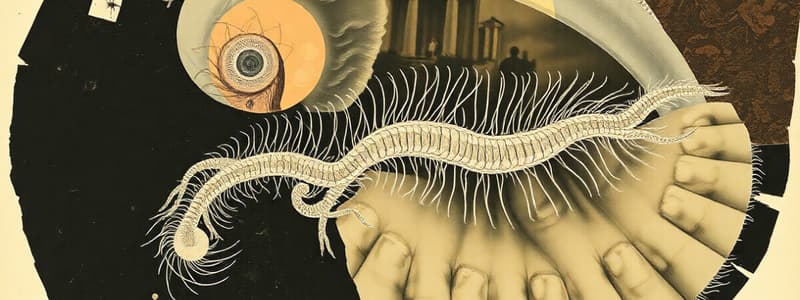Podcast
Questions and Answers
What term describes the phenomenon where adults resemble the juveniles of their ancestors?
What term describes the phenomenon where adults resemble the juveniles of their ancestors?
- Peramorphosis
- Neoteny
- Paedomorphosis (correct)
- Progenesis
Which law posits that embryonic development progresses from general forms to more specific forms?
Which law posits that embryonic development progresses from general forms to more specific forms?
- Von Baer's Law (correct)
- Heterochrony
- Morphological Law
- Biogenetic Law
In the context of evolution, what does the term 'ontogeny' specifically refer to?
In the context of evolution, what does the term 'ontogeny' specifically refer to?
- The conservation of body plans in evolution
- The evolutionary history of a species
- The physical changes seen during metamorphosis
- The lifelong development of an organism (correct)
What is 'heterochrony' primarily concerned with in terms of organismal development?
What is 'heterochrony' primarily concerned with in terms of organismal development?
What does 'peramorphosis' involve in terms of development?
What does 'peramorphosis' involve in terms of development?
Which of the following statements accurately describes the relationship between ontogeny and phylogeny according to Ernst Haeckel's argument?
Which of the following statements accurately describes the relationship between ontogeny and phylogeny according to Ernst Haeckel's argument?
How does von Baer's law differentiate between embryonic development patterns?
How does von Baer's law differentiate between embryonic development patterns?
Which process is characterized by adults resembling the juvenile stages of their ancestors?
Which process is characterized by adults resembling the juvenile stages of their ancestors?
In modern evolutionary developmental biology, which statement reflects the current understanding of embryonic development patterns?
In modern evolutionary developmental biology, which statement reflects the current understanding of embryonic development patterns?
What does the term 'heterochrony' encompass in the context of evolutionary biology?
What does the term 'heterochrony' encompass in the context of evolutionary biology?
Flashcards
Metamorphosis
Metamorphosis
Radical, abrupt changes from embryo to adult in animals
Ontogeny
Ontogeny
Development of an organism from fertilized egg to adult
Heterochrony
Heterochrony
Ontogenetic shift in timing of adult features
Paedomorphosis
Paedomorphosis
Signup and view all the flashcards
Von Baer's Law
Von Baer's Law
Signup and view all the flashcards
What is metamorphosis?
What is metamorphosis?
Signup and view all the flashcards
What is the biogenetic law?
What is the biogenetic law?
Signup and view all the flashcards
How does Von Baer's Law differ from the biogenetic law?
How does Von Baer's Law differ from the biogenetic law?
Signup and view all the flashcards
Hourglass model
Hourglass model
Signup and view all the flashcards
What is progenesis?
What is progenesis?
Signup and view all the flashcards
Study Notes
Embryonic Development Variations
- Vertebrate embryonic development varies across species.
- Some develop into larvae, others into fetuses.
- All major features develop during the fetal stage.
Metamorphosis
- Metamorphosis is a significant post-embryonic transformation to adulthood.
- This process is common in animals, including vertebrates.
- It involves distinct larval and adult stages.
- Thyroid hormones control metamorphosis.
- Metamorphosis may even predate vertebrates.
- Some non-vertebrate chordates, like lancelets, undergo metamorphosis, triggered by thyroid hormones.
- Non-jawed vertebrates exhibit metamorphosis.
Ontogeny
- Ontogeny is the development from organism to adulthood.
- This process occurs throughout an individual's lifespan.
Haeckel's Biogenetic Law
- Ernst Haeckel proposed that embryonic development mirrors evolutionary history.
- Ontogeny recapitulates phylogeny.
Von Baer's Law
- Karl Ernst von Baer stated development proceeds from general to specific.
- This is a fundamental principle of development.
Phylotypic Stage and Hourglass Model
- The vertebrate body plan is observed during the phylotypic stage.
- Embryonic development converges toward this conserved body plan, then diverges again (hourglass model).
- Modern evolutionary developmental biology supports von Baer's Law.
Heterochrony
- Heterochrony refers to changes in the timing of adult features in descendant species during development.
Paedomorphosis
- Paedomorphosis is when adult features resemble juvenile ancestors.
- It includes:
- Progenesis: Early cessation of somatic development (early sexual maturity)
- Neoteny: Features grow slower, sexual maturity surpasses somatic maturation.
Peramorphosis
- Peramorphosis involves extending the ancestral ontogenetic sequence, producing new adult forms.
Studying That Suits You
Use AI to generate personalized quizzes and flashcards to suit your learning preferences.




